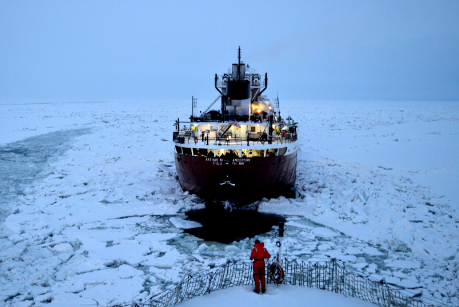Leavitt isn't alone. Ice provides crucial things to everyone who goes out on it. Respite for some, dearly held recreation for others, food, and much more. Snow and ice also are critical components of local U.S. economies across the region: Winter skiing and snowmobiling account for some $3.5 billion, a recent estimate said. A single ice fishing tournament can inject hundreds of thousands of dollars into communities.
拉维特并不是唯一一个这样的人。冰面为每一个出来站在上面的人都提供了至关重要的东西。对一些人来说是一个喘息的机会,对另一些人来说,这是一个非常重要的娱乐活动、食物,还有更多。与冰雪有关的活动也是整个地区当地经济的重要组成部分:最近的一项评估显示,冬季滑雪和雪地摩托大约贡献了35亿美元。而一场冰上钓鱼锦标赛可以为社区带来数十万美元的收入。
But in parts of Lake Superior, the ice season has been shrinking by an average of almost a day each year for the past few decades. That means the year Leavitt was born, a winter on Superior would have included more than a month more ice cover than it does today. Superior also is warming faster than every other large lake on Earth, except Lake Fracksjon in Sweden.
但是在苏必利尔湖的部分地区,在过去的几十年里,冰期平均每年要减少近一天。这意味着拉维特出生的那一年,苏必利尔的一个冬天,要比现在长一个多月左右。苏必利尔湖的变暖速度也比地球上其他任何一个大湖都要快,除了瑞典的Fracksjon湖。

The other Great Lakes' ice seasons are shrinking as well, by an average of about half a day per year. That may sound small and benign, but it masks much more critical change in a place where the line between ice and no ice, snow and rain, can be razor thin.
其他五大湖的冰期也在减少,平均每年减少约半天。这数字听起来可能不大,比较微妙,但它掩盖了这个地区一个更为关键的变化,那就是有冰还是无冰,下雪还是下雨的界线变得很难区分。
It's difficult to see the change clearly, in some cases, says Jia Wang, a climatologist at NOAA who focuses on ice cover in the Great Lakes region. Though they're hundreds of miles from the oceans, the lakes feel weather influences from both the Pacific and the Atlantic, and incorporate those weather patterns into their own.
关注五大湖区域的冰层覆盖情况的美国国家海洋和大气管理局气候学家王佳表示,在某些情况下,很难清楚地看到这种变化。尽管距离海洋有数百英里的距离,但这些湖泊还是受到了来自太平洋和大西洋的气候影响,并将这些气候模式融入到自己的模式中。













